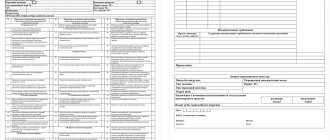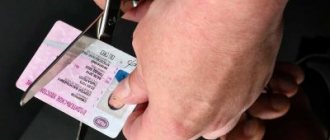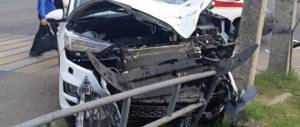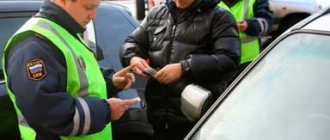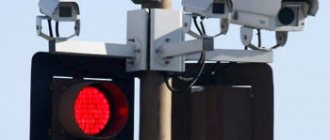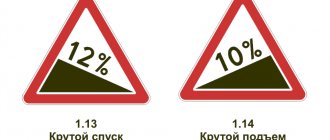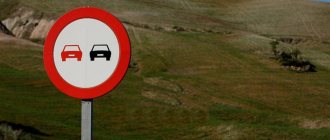The highway is a fairly busy road, which, like any road, is a place of increased danger. After all, when you are driving, you always need to be careful and attentive. Often on the track you have to overtake other cars, and this maneuver is considered the most dangerous and unpredictable. But how can you overtake cars so that it is as safe as possible? There are several rules that will allow you to overtake on the highway as safely as possible. Let's look at them below to understand exactly how to overtake other vehicles on the highway, and what it is better not to do.
In our opinion
The situation with road accidents leaves much to be desired. The authorities have done a lot in recent years to restore order on the country's roads. Unfortunately, these measures are not enough - the number of accidents has not decreased significantly. Naturally, the human factor plays a role here. The thing is that in our country there is a very low driving culture and a sense of responsibility towards others.
See also Rules for safe driving in rainy weather
Also, our simple Russian language often leads to stupid accidents with serious consequences. So it would not hurt many motorists to stop scolding the state for the dominance of traffic police cameras on the road, for increasing administrative liability for a number of traffic violations, and first of all, look at themselves from the outside. Maybe, in order to restore order on the roads, we first need to stop breaking traffic rules ourselves?
Now let's look at the most common questions that drivers ask on the Internet:
Is it possible to overtake trucks in places where there is a “No Overtaking” sign?
Russian legislation does not prohibit overtaking heavy vehicles, trucks and other vehicles, unless it is expressly prohibited by road markings, road signs and other traffic rules. But many people ask what to do if a truck or tractor is driving at a slow speed on a road where overtaking is prohibited, collecting a whole line of vehicles behind it.
According to the traffic rules, road sign 3.20 “Overtaking is prohibited” states that on the section of the road where it is installed, overtaking of all vehicles is prohibited, except for slow-moving vehicles, horse-drawn carts, bicycles, mopeds and two-wheeled motorcycles without a side trailer.
What is a low-speed vehicle? According to traffic regulations, a low-speed vehicle is a mechanical vehicle whose design speed does not exceed 30 km/h. Slow-moving vehicles must have a special sign (equilateral red triangle with yellow border). So, if you see a truck or tractor with such a sign, even if there is a “No Overtaking” sign, you can overtake.
If there is a truck, truck, etc. in front of you that is not a slow-moving vehicle, overtaking can only be done in places where it is permitted by markings and road signs.
By the way, do not forget that if you see a road sign “Overtaking is prohibited” and a solid marking line, overtaking a slow-moving vehicle is allowed. If there is no sign, but there is a solid marking line 1.1 or 1.11, overtaking a slow-moving vehicle is prohibited.
General points
Overtaking rules are often violated not only by beginners, but also by fairly experienced motorists who simply do not know how to perform this maneuver.
It is because of overtaking that half of the accidents occur, since entering the oncoming lane in violation of all the rules will most likely lead to a collision.
Since they are most often head-on, there are victims of such accidents, therefore, in order to prevent such incidents, it is necessary to understand what overtaking is and how to do it correctly.
First of all, you need to understand that if overtaking is carried out with violations, then the traffic police can draw up a report on such a driver, punishing him both financially and with a driving ban.
The traffic rules contain two concepts - overtaking and advancing, despite their similarity, they have a lot of different things, and they are interpreted separately by regulations.
Basic definitions
In order to understand the issue of correct overtaking, you should first become familiar with the basic concepts that work in the field of traffic rules.
This will allow the driver to independently study the law and the possible consequences of the violation, as well as understand how he can be punished for an incorrect maneuver.
| Term | Meaning |
| Overtaking | A driver maneuver that involves getting ahead of another vehicle in oncoming traffic. The main feature of overtaking is the oncoming traffic, as a result of which it should be carried out only after checking the situation on the road and confirming its safety |
| Advance | An action similar to overtaking, but without requiring entering the oncoming lane. Advancement is carried out within the lane of passing traffic at a speed higher than that of the vehicle being overtaken. |
| Fine | A financial penalty for administrative violations, which is imposed by a representative of law enforcement agencies and consists of paying a certain amount of money to the state budget. The size of the fine directly depends on the severity of the person’s guilt and the consequences of the violation |
What is it?
As mentioned earlier, overtaking is a maneuver in which a motorist gets ahead of another vehicle, while attempting to enter the oncoming lane.
The speed of movement during overtaking also increases, and the requirement is that the oncoming lane is clear and the maneuver is completed as quickly as possible, which will ensure that there is no interference for other drivers.
Overtaking is prohibited on some sections of the road and is regulated by law, so its violation will result in the drawing up of an administrative protocol.
Current regulatory framework
The most complete information about what overtaking is, as well as how to do it correctly, is contained in the Rules of the Road.
Section 11 is devoted to overtaking, which stipulates the main stages of overtaking, safety rules for this, and also establishes situations in which overtaking will be prohibited.
Considering that traffic rules are studied at the level of driving schools, even a novice driver needs to learn the rules of good overtaking.
The Code of Administrative Offenses thoroughly stipulates violation of the rules of overtaking; if the driver violates the rules of overtaking, he will be punished in the form of a fine or deprivation of his license.
Regarding overtaking, the sanction is established in Article 12.15, and the Code of Administrative Offenses additionally states that if a violation is recorded automatically, then only a fine will be imposed.
Details of the violation specifically related to overtaking are contained in paragraph 4 of the article and are used by traffic police inspectors.
Is it possible to overtake cars with special signals?
According to clause 3.2 of the Russian Federation Traffic Regulations, drivers are prohibited from overtaking vehicles that have special color schemes on the outer surface of the body, as well as a blue flashing light and a special sound signal.
In particular, it is prohibited to overtake vehicles that have special color schemes on them, with blue and red flashing lights turned on and a special sound signal, as well as the vehicle (accompanied by them).
Please note: the ban on overtaking special vehicles only applies if the car actually has color graphics on the body, a beacon and a special sound signal are turned on. If, for example, there is no sound signal, overtaking is allowed.
Is it possible to overtake a car with a blue special signal on if there are no special color schemes on the body? Yes, in this case, according to traffic regulations, overtaking is allowed, since this car, although equipped with a special signal, is not a special vehicle.
Also remember that overtaking is different from ahead. So it’s possible to get ahead of special vehicles that have color schemes, an activated beacon and an audible signal.
What is the penalty for crossing a double solid line on the road when overtaking?
Very often, drivers violate existing road markings on the road, which leads to accidents. The issue of crossing a double solid line when overtaking in the wrong place, prohibited by traffic regulations, is especially acute.
Many drivers not only forget about the serious responsibility for this type of violation, but also do not realize the real danger for all road users. Do not forget that the Rules of the Road are essentially written in blood, and road markings on certain sections of the road appeared for a reason.
First, let's remember what a “double solid” is:
Markup 1.3:
Crossing this marking is strictly prohibited!
These markings separate traffic flows in opposite directions on roads with four or more lanes. Also, double continuous markings are applied to roads with two or three lanes - with a lane width of more than 3.75 meters. That is, when moving next to a double solid line, if you cross it, you enter the oncoming lane, for which Russian legislation has administrative liability in accordance with Part 4 of Article 12.15 of the Code of Administrative Offenses of the Russian Federation - a fine of 5,000 rubles or deprivation of rights for a period of 4 to 6 months.
The legislation also provides for liability for repeated violations, provided for in Part 5 of Article 12.154 of the Code of Administrative Offenses of the Russian Federation. In this case, the driver will be deprived of his license for 1 year. However, if this violation was recorded by a complex of photo and video recording of traffic violations, the driver faces a fine of 5,000 rubles. A repeated violation is considered if the traffic rules are violated within a year from the date of the last offense.
How to overtake on the highway correctly
The basic principle when overtaking is this: the safest maneuver of this kind is performed in the shortest period of time.
Therefore, for overtaking, it is highly desirable that the difference between the speed at which two vehicles move is noticeable.
If there is such a difference, but it is not too great, then overtaking itself will not be a very reasonable decision.
Basic Rules
Along with the above-mentioned basic rule, there are a number of others, which are given below:
| If you're not sure, don't overtake | The driver who plans to overtake must be completely confident in its successful completion. He must know that his speed is fast enough to outpace the car in front of him. He must also see that in the oncoming traffic there is a sufficient distance to the nearest car. Overtaking in most cases involves risk and requires confidence on the part of the initiator that it will not lead to an unfavorable result. It must be remembered that in case of an accident, responsibility always falls on the initiator of overtaking. |
| Required to be given to the driver of the car | Riding in front, know that they are going to get ahead of him. Having approached it at a distance of approximately 15–20 meters, you should turn on the turn signal. In this case, the driver who is already following the overtaking person loses the right to begin overtaking him. |
| After you start overtaking, it is advisable to speed up | When the driver of the overtaking vehicle enters the oncoming lane, he can and should press the gas as hard as possible. It is necessary that the speed gap between his car and the one being overtaken increases as much as possible |
| When the car is in the oncoming lane | You need to pay as much attention as possible to what is happening in that lane further ahead. If there are concerns that overtaking may not work out, it makes sense to return to the previous lane without the planned advance of another car |
| If the driver successfully overtakes and completes it | Then he needs to avoid cutting off the overtaken car. It is required to take the previous lane smoothly. If there is a car in the oncoming lane ahead moving in the opposite direction, the left turn signal is signaled so that it understands that this maneuver is already being completed. At the same time, such a signal can warn the driver who decided to overtake the overtaken immediately after the data that another driver is moving relatively close in the oncoming direction, so the second overtaking person most likely does not have the opportunity to immediately get ahead of the overtaken |
| It is worth mentioning separately that such locomotives | In principle, they represent dangerous behavior on the road. This applies primarily to situations when, of two or several cars that are ahead of a certain vehicle together, the first is either a vehicle with large dimensions, it can be a jeep, or not a passenger car at all, but a bus or truck, or any vehicle tinted product. For all subsequent cars, such a leading vehicle creates rather a hindrance; because of it, they may not notice that someone is moving in the oncoming lane in such a way that the leading vehicle itself will have time to pass without risk, and the following ones will be in danger of getting hurt in an accident |
| The best way out when difficulties arise | If you incorrectly estimate the distance from a car in an oncoming lane or if there is a sudden obstacle from the overtaken car), the maneuver is twofold. If there is still such an opportunity, since the maneuver is at the very beginning, you should urgently return to your lane. If it is not there, then you need to switch to a lower gear (both automatic and manual) and reach maximum speed |
How to calculate the time that ensures the safety of the maneuver
When calculating the time to ensure the safety of overtaking, the car owner preparing for this maneuver needs to focus on the pace of movement of three cars at once.
He needs to keep in mind his own speed, as well as the car he is overtaking and the first car that is going in the opposite direction on the other side or in the oncoming lane.
In this case, your own speed and the speed of a car moving in the opposite direction must be added, this is the only way to determine whether the maneuver is safe.
Whether overtaking on tram tracks is allowed, see the article: overtaking on tram tracks. About overtaking on the right according to traffic rules, read here.
The reason is that the distance between these cars, which the car owner planning to overtake may consider sufficient, the two cars will only cover partly, each on its own side, and will meet in the middle if they are going at approximately the same speed.
At the same time, the speed at which the overtaken vehicle is traveling (its difference with the speed of the leading one) determines how long it will take to overtake.
So, if two cars are moving, one at a speed of 110 km/h, and the other at 100 km/h, then the difference in speed between them is only 10 km/h. This speed can be approximately represented as 3 m/s.
If we imagine the car being overtaken as stationary, then the overtaking vehicle, walking towards it at the same speed of 3 m/s, must travel approximately 30 meters in order to overtake it (this distance includes the dimensions of both cars and both distances between them, before overtaking and after overtaking ).
Thus, the advance will take him 10 seconds. On a real road, in the same 10 seconds, a vehicle will move 300 meters at a speed of 110 km/h (despite the fact that it will move forward only 30 meters in relation to the car it is overtaking).
If at a distance of 700 meters at the beginning of the maneuver there is a car moving at the same speed, then by the time it ends it will be in close proximity to the overtaking vehicle.
Therefore, if there is a car at the mentioned distance of 700 meters, such dangerous overtaking on the highway is no longer acceptable.
What is recommended when ahead of a truck?
When ahead of a truck, which presents particular difficulties due to the size of the vehicle, it is recommended to start accelerating at a certain distance from it.
If an overtaking car jumps into the oncoming lane directly from behind this vehicle, then it will have to accelerate in the oncoming lane, which will take time.
On the other hand, when driving into the oncoming lane and when a certain part of the truck’s dimensions are ahead in length, it is recommended to continue driving forward, even if a car traveling towards you is found in the oncoming lane at a dangerous distance. The truck is too long and you won’t be able to quickly return to your lane.
On the other hand, there is a high probability that the truck driver himself will start to brake in order to give the overtaking vehicle the opportunity to avoid a collision.
Of course, if in such a situation the overtaking driver decides to go back behind the truck, then due to misunderstanding he will significantly increase his chances of getting into an accident.
Video: detour in this area
What are the consequences of getting ahead of several vehicles at an intersection?
Overtaking several vehicles at one time is in principle permitted, provided that it does not interfere with traffic.
In particular, advancing at an intersection is allowed in contrast to overtaking, since in this case the driver simply moves along the line to the left at a higher speed than the car to the right of him.
However, passing a number of vehicles at an intersection is likely to lead to an accident, so it should be avoided if possible in this area by driving with caution.
Is it possible to overtake a cyclist?
Let us remind you that a bicycle is a vehicle, therefore, when overtaking it, you must strictly comply with the current Rules of the Road. Accordingly, if you violate current traffic rules when overtaking a cyclist, you will face administrative liability. For example, if you cross a double line when overtaking a cyclist, you will be charged under Article 12.15 of the Code of Administrative Offenses of the Russian Federation. However, let us remind you that in some cases you are allowed to overtake a cyclist even in places where overtaking is prohibited. The rules for overtaking a slow-moving vehicle, which is a bicycle, apply here.
Overtaking/getting ahead at an intersection: when is it possible?
It is known that overtaking at the intersection is prohibited. It is also prohibited to overtake if the car in front has turned on its left turn signal. Look at the situation in the picture. This maneuver of the blue car is allowed, since it is not considered overtaking (see above for what overtaking is). This example shows the advance of a car that, having turned on its turn signal to the left, is about to turn. There is no legal responsibility for the maneuver of a blue car.
Maneuver at an intersection
It is prohibited to maneuver at signalized intersections, and it is also prohibited to overtake vehicles at uncontrolled intersections. Only when you are driving on a secondary road. If your car is moving on the main road, then the maneuver can be performed. This is the only condition under which the traffic rules allow overtaking at intersections.
The rules clearly state that at such intersections the appropriate signs must be installed: 2.1 without signs, 2.3.1-2.3.7. The main road should not change direction. However, there are highways on which overtaking is prohibited, even if there are signs and the intersection is unregulated. This includes a main road with 4 or more lanes. In this case, you cannot overtake, but you can advance.
